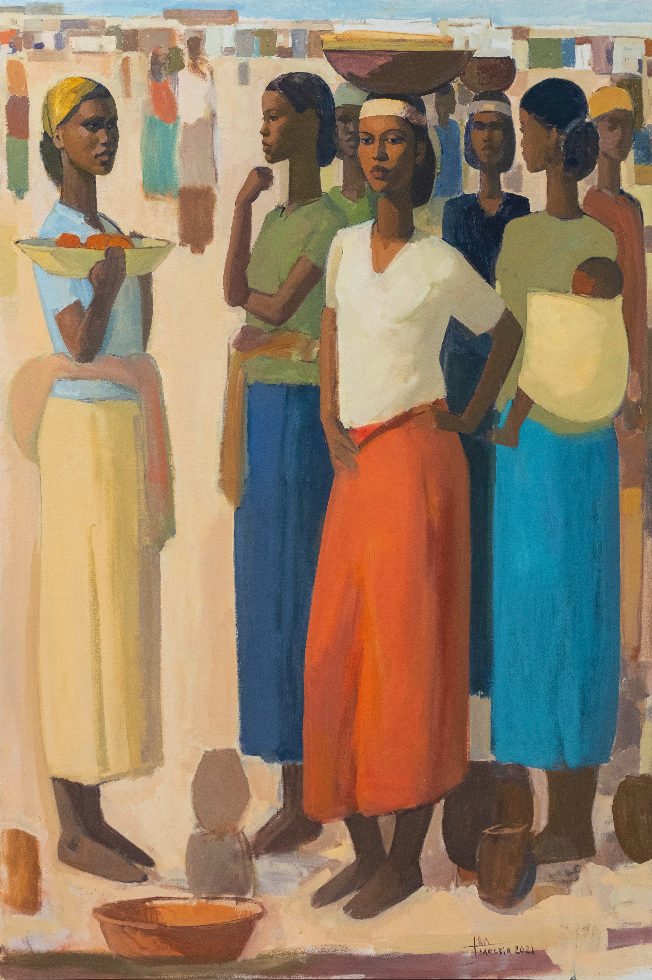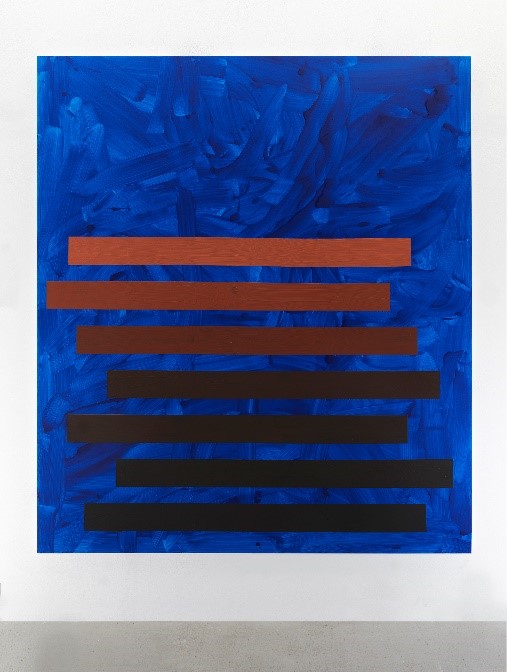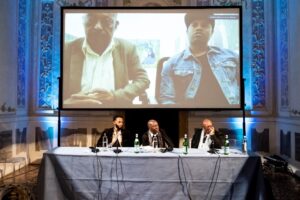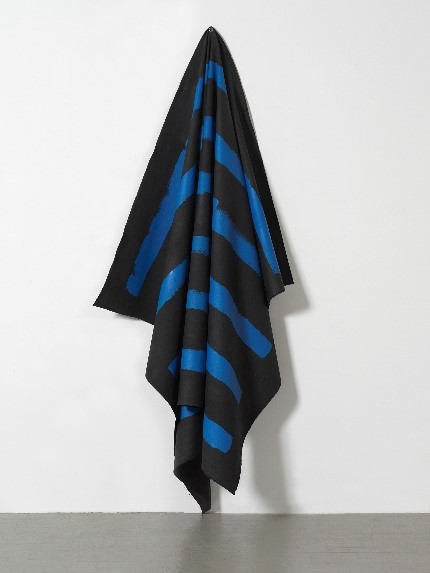
It’s difficult, if not impossible, to separate oneself from one’s roots. Ethiopia is a part of me as much as my Black identity is in the United States. My work is heavily focused on my identity to where I’ve grown up and where I currently live. I have hopes that my African background will, perhaps one day, lead to conversations about global Blackness. Being Black in other parts of the world isn’t the same as it is in North America – the struggles and challenges differ from place to place.
Christabel Johanson in conversation with Tariku Shiferaw
Kinfolk (Mereba), 2020. Courtesy of the artist and Addis Fine Art.
Focus Ethiopia & the Ethiopian Art Scene
In previous articles I have explored the question around African art being a fad in the Western world. Through this exploration one of the most empowering options was for African galleries and spaces to feature the art themselves. Putting the clout of these artworks within the hands of its community creates a positive economic, political and social impact. It also sends a powerful message that the curation and agency of African art doesn’t automatically belong in Western spaces.
To this end we have Addis Fine Art; the first contemporary white cube gallery space in Ethiopia. Rakeb Sile and Mesai Haileleul co-fouded Addis Fine Art in 2016. In 2019 it was described as one of the “Most Important Young Galleries in the World” by Artsy. Yet before the explosion of African art in the mainstream Haileleul remembers things were different, “I founded my own gallery in LA which focused on Ethiopian art. To be honest, although there was some degree of interest in the artists I was exhibiting, particularly from the Ethiopian community, wider interest was limited. This experience really taught me a lot about the art world’s receptiveness to ‘African art’ and how to run a gallery”.
Meanwhile Sile’s foray into Art started as a collector but it wasn’t until the pair met in LA that the idea for the gallery emerged. “Talking to Mesai made it clear to me how much he knew, and how much the rest of the art world was missing out on…Not long after we founded AFA [Addis Fine Art], we saw interest in African art increase, particularly here in London”. She continues “We could have opened a gallery anywhere in the world, but we both felt that we had to root it in Ethiopia, with a brick-and-mortar gallery, so that we would be able to interact with the artists there in person on a daily basis”.
In the past few years the gallery has become “one of the leading galleries in Africa, establishing a prominent international platform for artists from the Horn of Africa”. Its London branch opened in 2021 and established the gallery as a platform to present African art internationally, as well as a “space for artists from the diaspora to return to the continent and share and develop their practice”. Speaking of the gallery’s mission Sile believes it is their role to “connect these dots for an increasingly engaged international audience and showcase the talent that has emerged from Ethiopia and its diaspora”. In terms of proliferating African art within African spaces, the gallery is expanding its reach in order to achieve that. “Today, we have widened our lens and begun to work with more artists from the region, and we also hope to draw attention to the very best artists from neighbouring countries like Sudan, Eritrea, and Somalia”, says Sile.
The gallery adds that “Some artists challenge the assumed ‘African’ aesthetic and some use the rich tapestry of their cultural heritage as an integral part of their work. Regardless of how their art is expressed, the artists we work with are determined to convey their personal narratives and develop their creative practices in an increasingly interconnected world”.
This interconnectedness was no better illustrated when the gallery recently facilitated the Focus Ethiopia discussion. The panel which formed part of Venice Biennale’s cultural conversations held dialogue with “contemporary Ethiopian artists on new practices, opportunities, and challenges of contemporary art in their home country”. Invited to the discussion was modernist legend Tadesse Mesfin. Mesfin in particular taught many of the artists at the Alle School of Fine Arts and had in part inspired the birth of Addis Fine Art.

Tadesse Mesfin, Pillars of Life: Saturday Market VII, 2021. Courtesy of the artist and Addis Fine Art
Another panellist was artist Tariku Shiferaw. Shiferaw’s work has been described as geometric abstraction and his practice involves markings as a way of exploring hierarchies and social structures. In an interview with Galerie Lelong & Co, Shiferaw that “A mark, as physical and present as cave-markings… reveals the thinker behind the gesture—an evidence of prior markings of ideas and self onto the space”.
I spoke to Shiferaw to discuss Focus Ethiopia, his work and the Ethiopian art scene.

Photos courtesy of courtesy of Matteo Losurdo
Please talk about your background and previous artwork?
I am an artist who is currently living and working in New York City. I was born in Ethiopia and raised in Los Angeles, California. My ongoing body of work is titled, One of These Black Boys, which interrogates the concept of mark-making both within the space of painting and societal structures.
Where do you find inspiration?
I find inspiration in many places but the most significant have been my interest in painting and its history, Western social construct, and the politics of existing in such construct. Having conversations, reading books and essays on race theory, sci-fi, mythology, poetry, among other genera that I find interesting. And music.
What do you want viewers of your work to feel or think?
I can never control what viewers think or feel. However at the very minimum it’d be great to have my paintings inspire critical thinking and perhaps a passion for painting.

“Essence (WizKid & Tems)” 2022, acrylic on canvas, 96×84. © Tariku Shiferaw, Courtesy Galerie Lelong & Co., New York.
As your upbringing and introduction to art started in America, do you see the difference between Western and other global movements? For instance, could countries like Ethiopia be bringing a fresh perspective that Western art has lost touch with?
I wouldn’t exactly say a fresh perspective to art but perhaps something entirely different. Some of the challenges faced in the States are completely irrelevant to artists in Africa. They have a completely different urgency than we do here – Western struggles for racial equity is equally met with issues of class inequality within most African nations.
As part of the Ethiopian diaspora, do you find your work rooted in this culture or separate from it?
It’s difficult, if not impossible, to separate oneself from one’s roots. Ethiopia is a part of me as much as my Black identity is in the United States. My work is heavily focused on my identity to where I’ve grown up and where I currently live. I have hopes that my African background will, perhaps one day, lead to conversations about global Blackness. Being Black in other parts of the world isn’t the same as it is in North America – the struggles and challenges differ from place to place.
Many people whose culture or family heritage is rooted in different countries often go through a period of exploration into their history. Could you comment on this from your own perspective?
Yes, I’ve gone through such exploration that you mention. There is this simultaneous feeling of not belonging and belonging to both. It wasn’t until my first visit to Ethiopia that I realized I didn’t fully belong to as much as I had imagined I would for the majority of my life. It was a tough realization to be (partially) Othered in the culture I’ve always thought I had a reserved spot for me.
What were the key points you found most insightful from the Focus Ethiopia panel?
Hearing the perspectives of my colleagues Tadesse Mesfin and Tesfaye Urgessa. They shared a very different and unique perspectives based on their lived experiences as artists from Ethiopia.

Photo courtesy Matteo Losurdo
How do you respond to the statement that interest in African art is a fad?
Interest in African art and other non-Europeans has always existed, it’s just the first time it’s being presented by the actual participants of the culture. We can look ill-appropriation of Picasso’s ‘African masks’, as well as Barnet Newman and Jackson Pollock’s appropriation of native American concepts of mark-making. We’ve always been around; it just happens to be the first time in history that a multitude of us are being recognized for our works. Now, if your question is regarding the market, then that’s completely different – the market fluctuates and I don’t have an answer for you in that respect.

“Forgive Them Father (Ms Lauryn Hill)” 2020, acrylic on canvas, 79″x35″x16″. © Tariku Shiferaw, Courtesy Galerie Lelong & Co., New York.
Why do you think it is important for Ethiopian artists to emerge onto the global stage now?
Absolutely! It’s extremely important. Blackness or African-ness is not monolithic – there’s not many Ethiopian artists recognized at the global stage and it’d be significant to hear voices from all parts of Africa.
How do you think restrictions over the past 2 years have affected the art scene?
The lockdown has forced everyone to go online. This has created visibility for many artists that wouldn’t have had the opportunity to shine pre-pandemic.
How do you envision the scene moving forward as the world emerges from these restrictions?
It’s already back. The art world is moving along as it has always been but this time there’s a lot more artists of colour being recognized because of the pause during the pandemic.
What are you working on next?
I’m working on getting ready to show a new body of work titled, “Mata Semay,” as part of a group exhibition at Smack Mellon (in Dumbo, Brooklyn), June 25 – August 7th. In this series, I depict an imaginary night sky and constellations to engage a larger conversation around mark-making and the usage of mythologies as a tool to depict cultural values.
